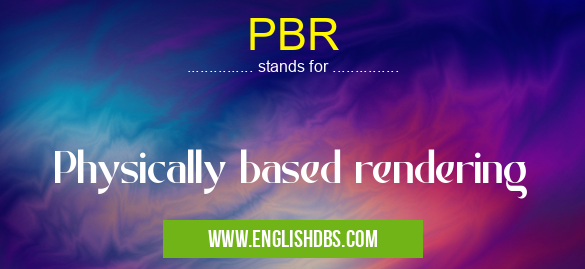What does PBR mean in UNCLASSIFIED
Physically based rendering (PBR) is a term used to describe a broad range of rendering techniques which are all grounded in the physical properties of light. It is an incredibly powerful tool for creating realistic visuals, as it takes detailed information from the environment and applies it to objects within the scene. PBR can be used to simulate any kind of surface, from metal to skin, and can generate highly realistic lighting and shadows. This makes PBR a valuable tool for anyone creating 3D graphics or digital scenes.

PBR meaning in Unclassified in Miscellaneous
PBR mostly used in an acronym Unclassified in Category Miscellaneous that means Physically based rendering
Shorthand: PBR,
Full Form: Physically based rendering
For more information of "Physically based rendering", see the section below.
Benefits Of Physically Based Rendering
One of the main benefits of using physically based rendering is its ability to create realistic visuals with minimal effort from the user. By gathering information from the environment, PBR does most of the work automatically so that users don't need to manually adjust parameters or tweak settings for each object or scene element they want rendered correctly. In addition, because PBR takes into account a multitude of tiny details it can produce high quality results that look incredibly close to reality with just one click. This makes it very useful for both professional filmmakers and video game developers who often have tight deadlines but still want their projects to look visually impressive.
Essential Questions and Answers on Physically based rendering in "MISCELLANEOUS»UNFILED"
What is Physically Based Rendering?
Physically based rendering (PBR) is a technique used in 3D computer graphics to create high-quality images and animations. The technique uses mathematical models of real-world lighting and materials to create realistic renders. By simulating physical phenomena such as light reflection, refraction, and absorption, PBR enables more natural looking imagery.
What are the benefits of Physically Based Rendering?
Physically based rendering provides better results than traditional techniques. It produces more realistic images that are closer to what you’d expect from the real world. Additionally, PBR requires less setup time since the parameters used can be relatively simple to understand and control. Furthermore, since it relies on physical laws instead of arbitrary values, it is easier to maintain consistent results across different platforms and engines.
How does Physically Based Rendering work?
PBR works by simulating the physics of light and its interaction with various materials in a three-dimensional space using mathematical models. First, a “rendering engine” takes in all the information about an environment—such as the direction of light and any surface properties like reflectivity and roughness—and calculates how those elements interact with each other. The resulting image will accurately depict how light would be reflected in real life scenarios.
What types of material can be rendered with Physically Based Rendering?
A wide range of surfaces can be rendered with PBR including metallic objects, glass surfaces, wood finishes, fabrics among others. Additionally, due to its reliance on physical laws instead of arbitrary values, PBR also allows for complex effects such as subsurface scattering which can produce realistic results for materials like skin or wax.
Do I need specialized hardware for Physically Based Rendering?
No specialized hardware is required for PBR; however having higher end components such as a graphics card or processor can improve performance significantly when rendering complex scenes or animations.
Can I use Physically Based Rendering in games?
Yes! Many popular game engines now support physically based rendering which allows developers to create stunning visuals similar to those found in movies or special effects scenes from films like The Matrix or Avatar. Some popular game engines that support PBR include Unreal Engine 4 and Unity 5.
Is Physically Based Rendering difficult to learn?
It depends on your experience level! If you’re familiar with 3D graphics software such as Maya or Blender then most likely you'll find picking up the basics fairly straightforward. However if you’re new to 3D graphics then there is definitely a learning curve involved as it requires some knowledge of mathematics and physics principles too.
What kind of workflow should I adopt when using Physically Based Rendering?
Generally speaking there are four main steps in a typical PBR workflow - Acquiring Data/Scenes; Applying Materials/Textures; Setting up Lighting conditions; Final Output/Rendering Processes & Inspecting/Tweaking Results until Satisfied.
Are there any limitations when using Physically Based Rendering?
There are certain visual effects that cannot be achieved through physically based rendering due to its realistic nature - highly stylized aesthetics may need another approach (e.g cel shading). Additionally if the scene contains very complex meshes then performance issues may arise due to increased memory requirements.
Final Words:
In conclusion, physically based rendering is an incredibly powerful tool for creating realistic visuals quickly and easily. By taking into account the physical properties of light and materials found in real life environments, PBR can generate stunningly accurate visuals without requiring manual adjustments or tweaking from users. As such, it has become an invaluable asset for filmmakers and video game developers who need high quality results in a short time frame.
PBR also stands for: |
|
| All stands for PBR |
